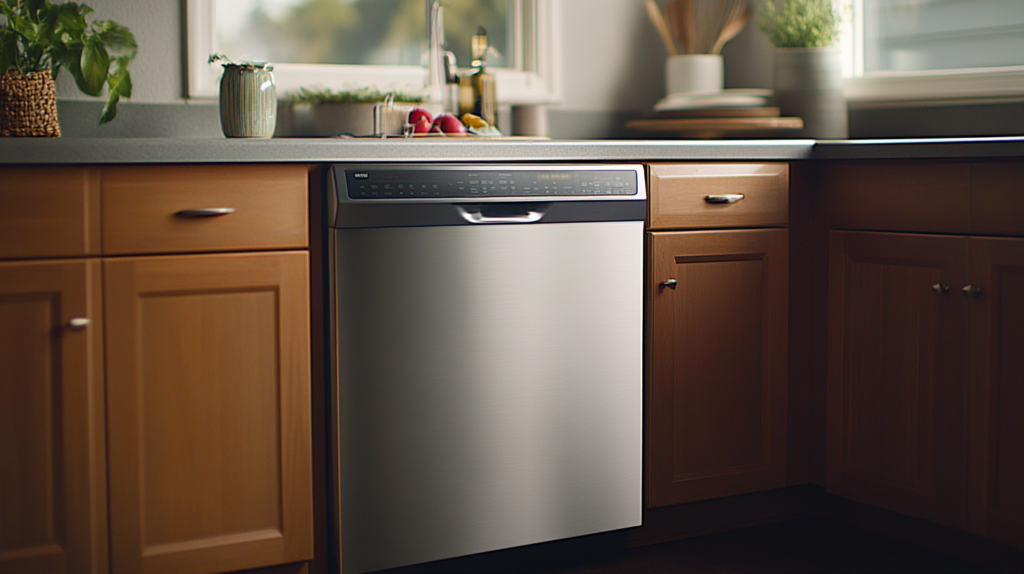
If your GE dishwasher isn’t draining properly, the drain pump may need replacement. This pump removes water during the drain cycle. When it malfunctions, water may pool at the bottom of the tub, preventing proper drainage.
Why Replace the Drain Pump Assembly?
The drain pump assembly is located beneath the dishwasher tub, connecting to the sump at the base. During operation, the pump moves water from the sump to the drain hose. If water remains in the tub after checking for blockages, it’s likely the pump is faulty and needs replacing.
Tools and Materials Needed
- 5/8-inch open-end wrench
- Flat-blade screwdriver
- Phillips screwdriver
- 5/16-inch nut driver
- 1/4-inch socket wrench
- Replacement drain pump assembly (WD26X10048)
- Towels to catch water drips
Safety Precautions
Follow these precautions to ensure safety while working:
- Disconnect Power: Turn off and unplug the dishwasher or switch off the circuit breaker to avoid electric shock.
- Shut Off Water Supply: Close the hot water supply line.
- Cool Down: Let the dishwasher cool if it was recently used.
- Clear Workspace: Keep the area well-lit, dry, and free from obstacles. Ensure children and pets are away.
- Dry Hands: Always work with dry hands to prevent electrical risks.
- Refer to the Manual: Review your user manual for specific safety or installation guidelines.
- Use Proper Tools: Handle parts carefully to avoid damage or injury.
- Wear Safety Gear: Use gloves to protect your hands from sharp edges and safety glasses to prevent debris from reaching your eyes.
- Handle Wires Safely: Avoid direct contact with exposed wires; use insulated tools if necessary.
Also Read: Preventing Dishwasher Clogs: The Vinegar Cycle Solution
How to Replace a GE Dishwasher Drain Pump
Access the Drain Pump
- Pull the dishwasher out from the cabinetry.
- Remove the cover caps from the side mounting screws using a flat-blade screwdriver.
- Use a Phillips screwdriver to remove the two screws securing the dishwasher.
- Carefully slide the dishwasher forward to access the connections at the back.
- Disconnect the water supply line from the valve using a 5/8-inch wrench.
- Loosen the drain hose clamp with a 5/16-inch nut driver and detach the hose from the air gap or garbage disposal.
- Pull the dishwasher completely out from under the counter.
- Tilt the dishwasher onto its side.
Remove the Old Drain Pump
- Locate the drain pump on the underside of the dishwasher.
- Pry off the electrical connector from the terminals using a flat-blade screwdriver.
- Loosen the hose clamps with a 5/16-inch nut driver and detach the drain hose from the pump inlet and outlet.
- Unscrew and remove the 1/4-inch screw securing the support hook with a socket wrench, then slide out the hook bracket.
- Use a socket wrench to remove the two 1/4-inch screws holding the counterweight and set it aside.
- Detach the drain pump from the sump and lift it out of the dishwasher base.
Install the New Drain Pump
- Reattach the counterweight using the two 1/4-inch screws and a socket wrench.
- Carefully insert the new drain pump into the sump and press it firmly into place.
- Reattach the drain hose to the outlet port and tighten the clamp securely with a 5/16-inch nut driver.
- Connect the electrical wiring to the terminals, ensuring correct polarity, and clip the connector into place.
Reinstall the Dishwasher
- Lift the dishwasher and slide it partially under the counter.
- Pull the drain hose, water line, and power cord through the opening.
- Push the dishwasher fully into position under the counter.
- Reconnect the drain line to the air gap or garbage disposal and tighten the hose clamp.
- Attach the water supply line to the inlet valve and tighten it with a 5/8-inch wrench.
- Secure the side mounting screws with a Phillips screwdriver.
- Snap the cover caps back into place to conceal the screws.
Preventing Future Drain Pump Issues
Once you’ve replaced the drain pump, there are steps you can take to extend its lifespan and avoid similar issues:
- Rinse Dishes: Remove large food particles and debris before loading dishes into the dishwasher to prevent blockages in the sump or pump.
- Clean Filters Regularly: Keep filters and strainers clear of debris to ensure proper water flow and reduce the strain on the pump.
- Inspect the Drain Hose: Periodically check the hose for kinks, clogs, or damage that could affect water flow.
- Use the Correct Detergent: Avoid using regular dish soap, as it can create excess suds that strain the pump.
- Schedule Maintenance: Perform routine maintenance, such as descaling and inspecting internal components, to keep the dishwasher running smoothly.
Also Read: How to replace turbidity sensor WD21X22830 in a GE dishwasher
Swapping out your GE dishwasher’s drain pump might seem like a big job, but with the right tools and a clear step-by-step guide, you can tackle it yourself and get your dishwasher back in top shape.
Those handy tips on maintenance will also help keep everything running smoothly for longer. No more standing around with puddles of water at the bottom of your dishwasher! So grab your tools, follow the steps, and enjoy the satisfaction of fixing it yourself.
